Military Park (Indianapolis)
Military Park is the oldest park in Indianapolis, Indiana, covering 14 acres (6 ha). It is located in western Downtown Indianapolis.
Military Park | |
 | |
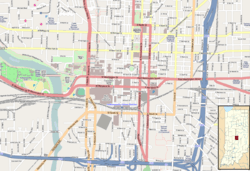 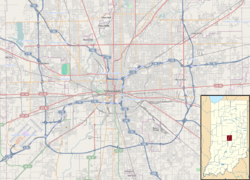   | |
| Location | Indianapolis, Indiana |
|---|---|
| Coordinates | 39°46′13.6″N 86°10′7.2″W |
| Built | 1852 |
| NRHP reference No. | 69000002 [1] |
| Added to NRHP | October 28, 1969 |
History
Ever since the founding of Indianapolis in 1820, the grounds of Military Park, originally called Military Ground, have seen various uses. The first documented celebration of Independence Day in Indianapolis occurred at Military Ground on July 4, 1822. The United States Congress officially gave the land to the state of Indiana in 1827, for use in training the local militias. Before 1860, its greatest use for militia training was for the Black Hawk War in 1836.[2][3]
In accordance with the 1851 Indiana Constitution, the land that forms Military Park cannot be sold; only Monument Circle and half of the Indiana State Capitol share this distinction.[4][5]. The first Indiana State Fair was held at the park in October 1852. Save for the years during which the fair traveled, the site was used for the state fair until it moved, in 1860, to the site where, during the Civil War, Camp Morton would be built. Stalls and exhibition halls were built on the grounds for such a purpose, surrounded by a large wooden fence. The State Fair made one last appearance on Military Park in 1863.[2]
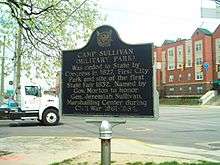
During the Civil War, Union soldiers were encamped at the Park. Governor Oliver P. Morton renamed the park Camp Sullivan, after the 13th Indiana Infantry's Colonel Jeremiah C. Sullivan. It was the first designated camp for the Federal army in Marion County, Indiana. However, this use severely damaged the grounds, due to all of the different troops entering and leaving Camp Sullivan, as it was a marshaling center. Following the war, efforts by local resident George Merritt started to improve the grounds, with the addition of a fountain and a small pool with a considerable-size rock foundation. Relics from the war and playground equipment were also added, as was a pavilion that still stands.[6][7]
William Jennings Bryan was notified that he would be the Democrat nominee for the Presidency of the United States on August 7, 1900. The two-hour rally was preceded by a march by the candidates from Indianapolis's Union Station.[8]
In 1916 the park was renamed Camp Sullivan Park. Between World War I and World War II, the park began to deteriorate. By now again known as Military Park, its diminished status continued until 1980, when the Lilly Endowment and Krannert Charitable Trust granted funds for its improvement.[9] In 1979 it became part of White River State Park.[10]
Today
Military Park hosts several events, such as rallies, festivals, DCI marching band practices, and outdoor concerts.
In 2007 the park's shelter house was renovated for over $700,000.[11]
References
- "National Register Information System". National Register of Historic Places. National Park Service. January 23, 2007.
- Bodenhamer 1008
- "Indiana State Historic Architectural and Archaeological Research Database (SHAARD)" (Searchable database). Department of Natural Resources, Division of Historic Preservation and Archaeology. Retrieved 2016-08-01. Note: This includes Wm. B. Barnes (September 1969). "National Register of Historic Places Inventory Nomination Form: Military Park" (PDF). Retrieved 2016-08-01. and Accompanying photographs
- Bodenhamer, David. The Encyclopedia of Indianapolis (Indiana University Press, 1994) pg.1008
- White River State Park Archived 2008-03-22 at the Wayback Machine
- Camp Sullivan (Military Park) Marker
- Bodenhamer 443, 1008, 1009
- All ready at Indianapolis; The Town Completes Arrangements For the Bryan Notification Ceremonies, New York Times, August 6, 1900
- Bodenhamer 1008, 1009
- Bodenhamer 1009
- Shelter House at Military Park Gets a Makeover - Newsroom - Inside INdiana Business with Gerry Dick Archived 2007-08-25 at the Wayback Machine

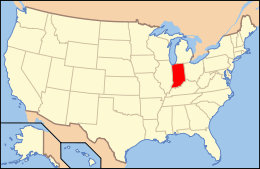
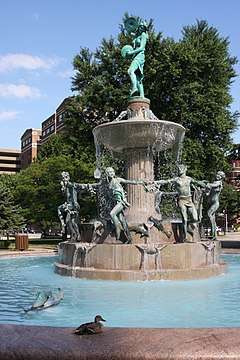
.svg.png)